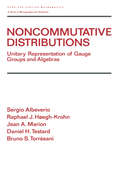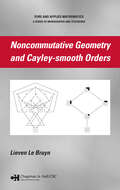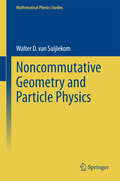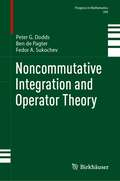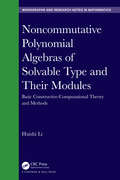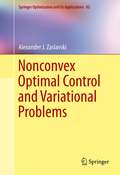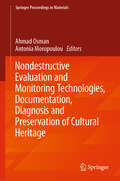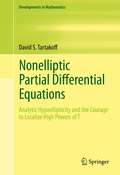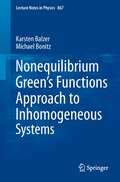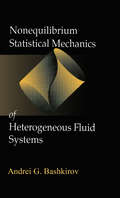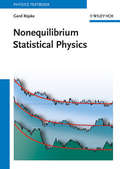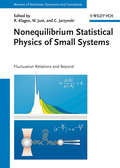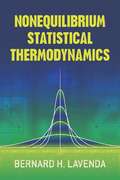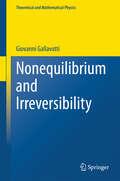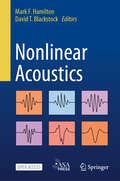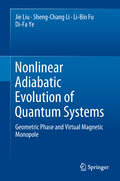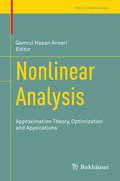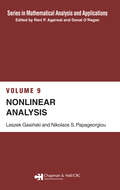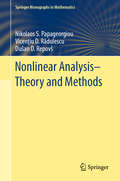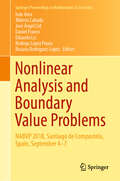- Table View
- List View
Noncommutative Distributions: Unitary Representation of Gauge Groups and Algebras (Chapman & Hall/CRC Pure and Applied Mathematics)
by Sergio Albeverio Raphael J. Hoegh-Krohn Jean A. Marion D. Testard B. TorresaniCovering important aspects of the theory of unitary representations of nuclear Lie groups, this self-contained reference presents the general theory of energy representations and addresses various extensions of path groups and algebras.;Requiring only a general knowledge of the theory of unitary representations, topological groups and elementary st
Noncommutative Geometry and Cayley-smooth Orders
by Lieven Le BruynNoncommutative Geometry and Cayley-smooth Orders explains the theory of Cayley-smooth orders in central simple algebras over function fields of varieties. In particular, the book describes the etale local structure of such orders as well as their central singularities and finite dimensional representations.After an introduction to partial d
Noncommutative Geometry and Particle Physics
by Walter D. SuijlekomThis book provides an introduction to noncommutative geometry and presents a number of its recent applications to particle physics. It is intended for graduate students in mathematics/theoretical physics who are new to the field of noncommutative geometry, as well as for researchers in mathematics/theoretical physics with an interest in the physical applications of noncommutative geometry. In the first part, we introduce the main concepts and techniques by studying finite noncommutative spaces, providing a "light" approach to noncommutative geometry. We then proceed with the general framework by defining and analyzing noncommutative spin manifolds and deriving some main results on them, such as the local index formula. In the second part, we show how noncommutative spin manifolds naturally give rise to gauge theories, applying this principle to specific examples. We subsequently geometrically derive abelian and non-abelian Yang-Mills gauge theories, and eventually the full Standard Model of particle physics, and conclude by explaining how noncommutative geometry might indicate how to proceed beyond the Standard Model.
Noncommutative Geometry and Particle Physics (Mathematical Physics Studies)
by Walter D. van SuijlekomThis book provides an introduction to noncommutative geometry and presents a number of its recent applications to particle physics. In the first part, we introduce the main concepts and techniques by studying finite noncommutative spaces, providing a “light” approach to noncommutative geometry. We then proceed with the general framework by defining and analyzing noncommutative spin manifolds and deriving some main results on them, such as the local index formula. In the second part, we show how noncommutative spin manifolds naturally give rise to gauge theories, applying this principle to specific examples. We subsequently geometrically derive abelian and non-abelian Yang-Mills gauge theories, and eventually the full Standard Model of particle physics, and conclude by explaining how noncommutative geometry might indicate how to proceed beyond the Standard Model. The second edition of the book contains numerous additional sections and updates. More examples of noncommutative manifolds have been added to the first part to better illustrate the concept of a noncommutative spin manifold and to showcase some of the key results in the field, such as the local index formula. The second part now includes the complete noncommutative geometric description of particle physics models beyond the Standard Model. This addition is particularly significant given the developments and discoveries at the Large Hadron Collider at CERN over the last few years. Additionally, a chapter on the recent progress in formulating noncommutative quantum theory has been included. The book is intended for graduate students in mathematics/theoretical physics who are new to the field of noncommutative geometry, as well as for researchers in mathematics/theoretical physics with an interest in the physical applications of noncommutative geometry.
Noncommutative Integration and Operator Theory (Progress in Mathematics #349)
by Ben de Pagter Peter G. Dodds Fedor A. SukochevThe purpose of this monograph is to provide a systematic account of the theory of noncommutative integration in semi-finite von Neumann algebras. It is designed to serve as an introductory graduate level text as well as a basic reference for more established mathematicians with interests in the continually expanding areas of noncommutative analysis and probability. Its origins lie in two apparently distinct areas of mathematical analysis: the theory of operator ideals going back to von Neumann and Schatten and the general theory of rearrangement invariant Banach lattices of measurable functions which has its roots in many areas of classical analysis related to the well-known Lp-spaces. A principal aim, therefore, is to present a general theory which contains each of these motivating areas as special cases.
Noncommutative Polynomial Algebras of Solvable Type and Their Modules: Basic Constructive-Computational Theory and Methods (Chapman & Hall/CRC Monographs and Research Notes in Mathematics)
by Huishi LiNoncommutative Polynomial Algebras of Solvable Type and Their Modules is the first book to systematically introduce the basic constructive-computational theory and methods developed for investigating solvable polynomial algebras and their modules. In doing so, this book covers: A constructive introduction to solvable polynomial algebras and Gröbner basis theory for left ideals of solvable polynomial algebras and submodules of free modules The new filtered-graded techniques combined with the determination of the existence of graded monomial orderings The elimination theory and methods (for left ideals and submodules of free modules) combining the Gröbner basis techniques with the use of Gelfand-Kirillov dimension, and the construction of different kinds of elimination orderings The computational construction of finite free resolutions (including computation of syzygies, construction of different kinds of finite minimal free resolutions based on computation of different kinds of minimal generating sets), etc. This book is perfectly suited to researchers and postgraduates researching noncommutative computational algebra and would also be an ideal resource for teaching an advanced lecture course.
Nonconvex Optimal Control and Variational Problems
by Alexander J. ZaslavskiNonconvex Optimal Control and Variational Problems is an important contribution to the existing literature in the field and is devoted to the presentation of progress made in the last 15 years of research in the area of optimal control and the calculus of variations. This volume contains a number of results concerning well-posedness of optimal control and variational problems, nonoccurrence of the Lavrentiev phenomenon for optimal control and variational problems, and turnpike properties of approximate solutions of variational problems. Chapter 1 contains an introduction as well as examples of select topics. Chapters 2-5 consider the well-posedness condition using fine tools of general topology and porosity. Chapters 6-8 are devoted to the nonoccurrence of the Lavrentiev phenomenon and contain original results. Chapter 9 focuses on infinite-dimensional linear control problems, and Chapter 10 deals with "good" functions and explores new understandings on the questions of optimality and variational problems. Finally, Chapters 11-12 are centered around the turnpike property, a particular area of expertise for the author. This volume is intended for mathematicians, engineers, and scientists interested in the calculus of variations, optimal control, optimization, and applied functional analysis, as well as both undergraduate and graduate students specializing in those areas. The text devoted to Turnpike properties may be of particular interest to the economics community.
Nondestructive Evaluation and Monitoring Technologies, Documentation, Diagnosis and Preservation of Cultural Heritage (Springer Proceedings in Materials)
by Antonia Moropoulou Ahmad OsmanThis book highlights the benefits of Non-Destructive Testing (NDT) methods and their applications on several cultural heritage sites including the Holy Selphuchre Monitoring System in Jerusalem. This book demonstrates Nondestructive sensing technologies and inspection modules as main tools for documentation, diagnosis, characterization, preservation planning, monitoring and quality of restoration, assessment and evaluation of material and preservation work.
Nonelliptic Partial Differential Equations
by David S. TartakoffThis book provides a very readable description of a technique, developed by the author years ago but as current as ever, for proving that solutions to certain (non-elliptic) partial differential equations only have real analytic solutions when the data are real analytic (locally). The technique is completely elementary but relies on a construction, a kind of a non-commutative power series, to localize the analysis of high powers of derivatives in the so-called bad direction. It is hoped that this work will permit a far greater audience of researchers to come to a deep understanding of this technique and its power and flexibility.
Nonequilibrium Green's Functions Approach to Inhomogeneous Systems
by Karsten Balzer Michael BonitzThis book offers a self-contained introduction to non-equilibrium quantum particle dynamics for inhomogeneous systems, including a survey of recent breakthroughs pioneered by the authors and others. The approach is based on real-time Green's functions.
Nonequilibrium Many-Body Theory of Quantum Systems
by Gianluca Stefanucci Robert Van LeeuwenThe Green's function method is one of the most powerful and versatile formalisms in physics, and its nonequilibrium version has proved invaluable in many research fields. This book provides a unique, self-contained introduction to nonequilibrium many-body theory. Starting with basic quantum mechanics, the authors introduce the equilibrium and nonequilibrium Green's function formalisms within a unified framework called the contour formalism. The physical content of the contour Green's functions and the diagrammatic expansions are explained with a focus on the time-dependent aspect. Every result is derived step-by-step, critically discussed and then applied to different physical systems, ranging from molecules and nanostructures to metals and insulators. With an abundance of illustrative examples, this accessible book is ideal for graduate students and researchers who are interested in excited state properties of matter and nonequilibrium physics.
Nonequilibrium Phase Transitions in Driven Vortex Matter: The Reversible-Irreversible Transition, Dynamical Ordering, and Kibble-Zurek Mechanism (Springer Theses)
by Shun MaegochiThis book presents experimental studies of nonequilibrium phase transitions induced by ac and dc forces in collectively interacting systems—a superconducting vortex system with random pinning. It first shows that a phase transition from reversible to irreversible flow occurs by increasing vortex density as well as amplitude of ac shear, which is indicative of the universality of the reversible-irreversible transition. Two distinct flow regimes are also found in the reversible phase. Next, the book presents new methods for dc driven experiments—transverse mode-locking and transverse current-voltage measurements—and provides convincing evidence of the second-order dynamical transition from disordered plastic to anisotropically ordered smectic flow. Lastly it reports on the first experimental demonstration of the Kibble-Zurek mechanism for the nonequilibrium phase transition.The experimental results indicate that both the reversible-irreversible transition and the dynamical ordering transition belong to the directed percolation universality class which is one of the fundamental classes of nonequilibrium phase transitions. Hence, the findings will be generalized to other nonequilibrium systems and stimulate research on nonequilibrium physics.
Nonequilibrium Statistical Mechanics of Heterogeneous Fluid Systems
by Andrei G. BashkirovThere is a wide variety of heterogeneous fluid systems that possess interphase surfaces. This monograph is devoted to pioneering studies in nonequilibrium statistical mechanics of such systems. Starting from the Liouville equation, the equations of surface hydrodynamics are derived with allowance for discontinuities of thermodynamic parameters of interphase boundaries. Brownian motion of a large solid particle in a fluid and nucleation are treated as results of fluctuations of flows across particle surfaces. With the use of the Gibbs method, a shock wave in a gas is considered as a sort of an interphase surface, and the surface tension of a shock front is introduced for the first time.
Nonequilibrium Statistical Physics
by Gerd RöpkeAuthored by a well-known expert in the field of nonequilibrium statistical physics, this book is a coherent presentation of the subject suitable for masters and PhD students, as well as postdocs in physics and related disciplines. Starting from a general discussion of irreversibility and entropy, the method of nonequilibrium statistical operator is presented as a general concept. Stochastic processes are introduced as a necessary prerequisite to describe the evolution of a nonequilibrium state. Different standard approaches such as master equations, kinetic equations and linear response theory, are derived after special assumptions. This allows for an insight into the problems of nonequilibrium physics, a discussion of the limits of the approaches, and suggestions for improvements. The method of thermodynamic Green's function is outlined that allows for the systematic quantum statistical treatment of many-body systems. Applications and typical examples are given, as well as fully worked problems.
Nonequilibrium Statistical Physics of Small Systems
by Heinz Georg Schuster Christopher Jarzynski Rainer Klages Wolfram JustThis book offers a comprehensive picture of nonequilibrium phenomena in nanoscale systems. Written by internationally recognized experts in the field, this book strikes a balance between theory and experiment, and includes in-depth introductions to nonequilibrium fluctuation relations, nonlinear dynamics and transport, single molecule experiments, and molecular diffusion in nanopores.The authors explore the application of these concepts to nano- and biosystems by cross-linking key methods and ideas from nonequilibrium statistical physics, thermodynamics, stochastic theory, and dynamical systems. By providing an up-to-date survey of small systems physics, the text serves as both a valuable reference for experienced researchers and as an ideal starting point for graduate-level students entering this newly emerging research field.
Nonequilibrium Statistical Thermodynamics (Dover Books on Physics)
by Bernard H. LavendaThis book develops in detail the statistical foundations of nonequilibrium thermodynamics, based on the mathematical theory of Brownian motion. Author Bernard H. Lavenda demonstrates that thermodynamic criteria emerge in the limit of small thermal fluctuations and in the Gaussian limit where means and modes of the distribution coincide. His treatment assumes the theory of Brownian motion to be a general and practical model of irreversible processes that are inevitably influenced by random thermal fluctuations. This unifying approach permits the extraction of widely applicable principles from the analysis of specific models.Arranged by argument rather than theory, the text is based on the premises that random thermal fluctuations play a decisive role in governing the evolution of nonequilibrium thermodynamic processes and that they can be viewed as a dynamic superposition of many random events. Intended for nonmathematicians working in the areas of nonequilibrium thermodynamics and statistical mechanics, this book will also be of interest to chemical physicists, condensed matter physicists, and readers in the area of nonlinear optics.
Nonequilibrium and Irreversibility
by Giovanni GallavottiThis book concentrates on the properties of the stationary states in chaotic systems of particles or fluids, leaving aside the theory of the way they can be reached. The stationary states of particles or of fluids (understood as probability distributions on microscopic configurations or on the fields describing continua) have received important new ideas and data from numerical simulations and reviews are needed. The starting point is to find out which time invariant distributions come into play in physics. A special feature of this book is the historical approach. To identify the problems the author analyzes the papers of the founding fathers Boltzmann, Clausius and Maxwell including translations of the relevant (parts of) historical documents. He also establishes a close link between treatment of irreversible phenomena in statistical mechanics and the theory of chaotic systems at and beyond the onset of turbulence as developed by Sinai, Ruelle, Bowen (SRB) and others: the author gives arguments intending to support strongly the viewpoint that stationary states in or out of equilibrium can be described in a unified way. In this book it is the "chaotic hypothesis", which can be seen as an extension of the classical ergodic hypothesis to non equilibrium phenomena, that plays the central role. It is shown that SRB - often considered as a kind of mathematical playground with no impact on physical reality - has indeed a sound physical interpretation; an observation which to many might be new and a very welcome insight. Following this, many consequences of the chaotic hypothesis are analyzed in chapter 3 - 4 and in chapter 5 a few applications are proposed. Chapter 6 is historical: carefully analyzing the old literature on the subject, especially ergodic theory and its relevance for statistical mechanics; an approach which gives the book a very personal touch. The book contains an extensive coverage of current research (partly from the authors and his coauthors publications) presented in enough detail so that advanced students may get the flavor of a direction of research in a field which is still very much alive and progressing. Proofs of theorems are usually limited to heuristic sketches privileging the presentation of the ideas and providing references that the reader can follow, so that in this way an overload of this text with technical details could be avoided.
Nonequilibrium and Irreversibility (Lecture Notes in Physics #1040)
by Giovanni GallavottiThis 2nd edition of the book focuses on the properties of stationary states in chaotic systems of particles or fluids, setting aside the theory of how these states are achieved. The second edition has been thoroughly revised and includes numerous corrections. It incorporates recent findings, with particular emphasis on the equivalence between irreversible and reversible equations. The ongoing debate over reversibility and irreversible behavior is frequently discussed. The book seeks to unify the study of stationary nonequilibrium states with that of equilibrium states, using the paradigm offered by the simplest chaotic systems, specifically Anosov systems. The book begins by exploring the time-invariant distributions relevant to physics. A distinctive feature of this work is its historical approach. To clarify foundational issues, the author analyzes the works of pioneering figures like Boltzmann, Clausius, and Maxwell, including translated excerpts of key historical documents. Additionally, the author establishes a close connection between the treatment of irreversible phenomena in statistical mechanics and the theory of chaotic systems, particularly at and beyond the onset of turbulence, as developed by Sinai, Ruelle, and Bowen (SRB) and others. Arguments are presented to strongly support the perspective that stationary states, whether in equilibrium or not, can be described in a unified framework. The book offers extensive coverage of contemporary research, presented in sufficient detail to give advanced students a sense of the ongoing research directions in this dynamic field. Proofs of theorems are generally limited to heuristic outlines, favoring the presentation of concepts and providing references for further study, thereby avoiding an overload of technical detail in the main text.
Nonlinear Acoustics
by Mark F. Hamilton David T. BlackstockThis open access book is an introductory text on the theory of nonlinear acoustics authored by experts on their respective topics. It is written at a level appropriate for a graduate course on nonlinear acoustics, and it also serves as a useful resource for scientists and engineers. Consistent notation is employed for the principal symbols, and there is extensive cross-referencing between chapters. Chapters 1 through 8 develop the physical concepts, mathematical models, and classical methods of solution that form the theoretical framework for nonlinear acoustics. These chapters, or selected portions, form an appropriate core for an introductory course. While the emphasis is on nonlinear sound waves in fluids, Chapter 9 provides an introduction to nonlinear elastic waves in isotropic solids. Chapters 10 through 15 cover applications and additional methodologies encountered in nonlinear acoustics that include perturbation and numerical methods, ray theory for inhomogeneous moving media, statistical and parametric phenomena, and biomedical applications. The book is relevant to studies of therapeutic ultrasound, blast waves and jet noise, nondestructive testing, parametric array loudspeakers, particle manipulation with acoustic radiation force, and other applications involving nonlinear acoustics. This is an open access book.
Nonlinear Adiabatic Evolution of Quantum Systems: Geometric Phase and Virtual Magnetic Monopole
by Jie Liu Sheng-Chang Li Li-Bin Fu Di-Fa YeThis book systematically introduces the nonlinear adiabatic evolution theory of quantum many-body systems. The nonlinearity stems from a mean-field treatment of the interactions between particles, and the adiabatic dynamics of the system can be accurately described by the nonlinear Schrödinger equation. The key points in this book include the adiabatic condition and adiabatic invariant for nonlinear system; the adiabatic nonlinear Berry phase; and the exotic virtual magnetic field, which gives the geometric meaning of the nonlinear Berry phase. From the quantum-classical correspondence, the linear and nonlinear comparison, and the single particle and interacting many-body difference perspectives, it shows a distinct picture of adiabatic evolution theory. It also demonstrates the applications of the nonlinear adiabatic evolution theory for various physical systems. Using simple models it illustrates the basic points of the theory, which are further employed for the solution of complex problems of quantum theory for many-particle systems. The results obtained are supplemented by numerical calculations, presented as tables and figures.
Nonlinear Analysis
by Panos M. Pardalos Hari M. Srivastava Pando G. GeorgievThe volume will consist of about 40 articles written by some very influential mathematicians of our time and will expose the latest achievements in the broad area of nonlinear analysis and its various interdisciplinary applications.
Nonlinear Analysis
by Qamrul Hasan AnsariMany of our daily-life problems can be written in the form of an optimization problem. Therefore, solution methods are needed to solve such problems. Due to the complexity of the problems, it is not always easy to find the exact solution. However, approximate solutions can be found. The theory of the best approximation is applicable in a variety of problems arising in nonlinear functional analysis and optimization. This book highlights interesting aspects of nonlinear analysis and optimization together with many applications in the areas of physical and social sciences including engineering. It is immensely helpful for young graduates and researchers who are pursuing research in this field, as it provides abundant research resources for researchers and post-doctoral fellows. This will be a valuable addition to the library of anyone who works in the field of applied mathematics, economics and engineering.
Nonlinear Analysis (Mathematical Analysis and Applications)
by Leszek Gasinski Nikolaos S. PapageorgiouNonlinear analysis is a broad, interdisciplinary field characterized by a remarkable mixture of analysis, topology, and applications. Its concepts and techniques provide the tools for developing more realistic and accurate models for a variety of phenomena encountered in fields ranging from engineering and chemistry to economics and biology.Thi
Nonlinear Analysis - Theory and Methods (Springer Monographs in Mathematics)
by Nikolaos S. Papageorgiou Vicenţiu D. Rădulescu Dušan D. RepovšThis book emphasizes those basic abstract methods and theories that are useful in the study of nonlinear boundary value problems. The content is developed over six chapters, providing a thorough introduction to the techniques used in the variational and topological analysis of nonlinear boundary value problems described by stationary differential operators. The authors give a systematic treatment of the basic mathematical theory and constructive methods for these classes of nonlinear equations as well as their applications to various processes arising in the applied sciences. They show how these diverse topics are connected to other important parts of mathematics, including topology, functional analysis, mathematical physics, and potential theory. Throughout the book a nice balance is maintained between rigorous mathematics and physical applications. The primary readership includes graduate students and researchers in pure and applied nonlinear analysis.
Nonlinear Analysis and Boundary Value Problems: NABVP 2018, Santiago de Compostela, Spain, September 4-7 (Springer Proceedings in Mathematics & Statistics #292)
by Alberto Cabada Iván Area José Ángel Cid Daniel Franco Eduardo Liz Rodrigo López Pouso Rosana Rodríguez-LópezThis book is devoted to Prof. Juan J. Nieto, on the occasion of his 60th birthday. Juan José Nieto Roig (born 1958, A Coruña) is a Spanish mathematician, who has been a Professor of Mathematical Analysis at the University of Santiago de Compostela since 1991. His most influential contributions to date are in the area of differential equations. Nieto received his degree in Mathematics from the University of Santiago de Compostela in 1980. He was then awarded a Fulbright scholarship and moved to the University of Texas at Arlington where he worked with Professor V. Lakshmikantham. He received his Ph.D. in Mathematics from the University of Santiago de Compostela in 1983. Nieto's work may be considered to fall within the ambit of differential equations, and his research interests include fractional calculus, fuzzy equations and epidemiological models. He is one of the world’s most cited mathematicians according to Web of Knowledge, and appears in the Thompson Reuters Highly Cited Researchers list. Nieto has also occupied different positions at the University of Santiago de Compostela, such as Dean of Mathematics and Director of the Mathematical Institute. He has also served as an editor for various mathematical journals, and was the editor-in-chief of the journal Nonlinear Analysis: Real World Applications from 2009 to 2012. In 2016, Nieto was admitted as a Fellow of the Royal Galician Academy of Sciences. This book consists of contributions presented at the International Conference on Nonlinear Analysis and Boundary Value Problems, held in Santiago de Compostela, Spain, 4th-7th September 2018. Covering a variety of topics linked to Nieto’s scientific work, ranging from differential, difference and fractional equations to epidemiological models and dynamical systems and their applications, it is primarily intended for researchers involved in nonlinear analysis and boundary value problems in a broad sense.
